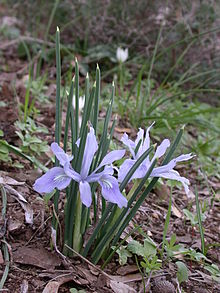| Iris vartanii | |
|---|---|

| |
| Conservation status | |
 Vulnerable (IUCN 3.1) | |
| Scientific classification | |
| Kingdom: | Plantae |
| Clade: | Tracheophytes |
| Clade: | Angiosperms |
| Clade: | Monocots |
| Order: | Asparagales |
| Family: | Iridaceae |
| Genus: | Iris |
| Subgenus: | Iris subg. Hermodactyloides |
| Section: | Iris sect. Reticulatae |
| Species: | I. vartanii |
| Binomial name | |
| Iris vartanii Foster | |
| Synonyms | |
|
Iridodictyum vartanii (Foster) Rodion. | |
Iris vartanii is a plant species in the genus Iris. It is classified in the subgenus Hermodactyloides and section Reticulatae. It is a bulbous perennial.
It was once thought to be part of the Iris subgenus Xiphium. It is sometimes referred to as 'Vartanni Iris', or 'Iris vartani'.
It was first described in 1885 in Gardeners' Chronicle, and an illustration (No.6942) was published in Curtis's Botanical Magazine two years later. It was named by Sir Michael Foster after Dr. Kaloost Vartan from Nazareth. Who discovered the iris while working in Palestine in the foothills around Nazareth, and sent the specimen to Foster for classification. It was originally described as brown in colour, presumably due to deterioration in transportation.
Habit
It has four leaves that are un-equalsided and up to 20 cm tall (when in flower), but that increases to nearly 40 cm later.
It flowers between October and December. The flowers are greyish lilac-white, (or slaty blue ) with falls having dark blue veins. The flowers smell of almonds.
Due to its early flowering (during winter), the leaves can be damaged (by snow and ice) so much that the plant does not form healthy bulbs for the next year. So it is best grown like other species of iris in an alpine house or bulb frame. It is hardy to USDA Zone 3.
Like other members of the reticulata group (including Iris danfordiae), it has the habit of the main bulb splitting into many bulblets, that can take many years (between 2–3 years) to reach flowering size again.
Distribution
It was originally found near the city of Nazareth in Israel. and it was also found in Jordan and Syria. On rocky hillsides. It is found in Golan, Galilee, Mount Carmel, Samarian desert and Judean Mountains, various regions of Levantine. But according to Dr Dawud Al-Eisawi's book Field Guide to Wild Flowers of Jordan (1998), it is now thought to be extinct in Jordan.
Cultivar
I. vartanii White pearl First found in 1910 in Beersheba and Hebron, it was originally thought to be a white form of I. histrioides. On 21 December 1912, it was described in The Garden magazine of the Royal Horticultural Society, now as a white form of I. vartanii. Then in 1913, it gained Award of Merit by the RHS.
It is sometimes referred to as Iris vartanii var. alba.
References
- Sapir, Y.; Fragman-Sapir, O. "Iris vartanii". IUCN Red List of Threatened Species. Retrieved 19 March 2020.
- "Iris vartanii Foster". theplantlist.org. Retrieved 31 October 2014.
- "Botanical Magazine" (PDF). www.ars-grin.gov. p. 12. Retrieved 21 July 2014.
- ^ Moira McCrossan, Hugh Taylor Jordan , p. 8, at Google Books
- Dyke, William Rickatson (6 July 1907). "DYKES ON IRISES" (PDF). www.beardlessiris.org. p. 6. Retrieved 21 July 2014.
- ^ Walters, Stuart Max (Editor)European Garden Flora: A Manual for the Identification of Plants Cultivated, p. 354, at Google Books
- ^ Foster, Prof. Michael (3 May 1892). "Bulbous Irises". Retrieved 16 July 2014.
- ^ Cassidy, G.E.; Linnegar, S. (1987). Growing Irises (Revised ed.). Bromley: Christopher Helm. pp. 144–145. ISBN 0-88192-089-4.
- ^ Lynch, RichardThe Book of the Iris, p. 164, at Google Books
- Dykes, W. R. (5 January 1924). "DYKES ON IRISES (reprints his contributions to various journals) inc. 'The Garden'" (PDF). Retrieved 16 July 2014.
- "Iris vartanii". Germplasm Resources Information Network. Agricultural Research Service, United States Department of Agriculture. Retrieved 11 July 2014.
- "Iris vartanii". encyclopaedia.alpinegardensociety.net. Retrieved 21 July 2014.
- "Iris vartanii". www.wildflowers.co.il. Retrieved 9 August 2014.
- "Black on black or "Iris petrana"". 2005. Retrieved 21 July 2014.
- "(SPEC) 'White Pearl'". wiki.irises.org (American Iris Society). Retrieved 19 July 2014.
Other sources
- Danin, A. 2004. Distribution atlas of plants in the Flora Palaestina area.
- Mathew, B. 1981. The Iris. 179.
- Zohary, M. & N. Feinbrun-Dothan. 1966–. Flora palaestina.
External links
 Media related to Iris vartanii at Wikimedia Commons
Media related to Iris vartanii at Wikimedia Commons Data related to Iris vartanii at Wikispecies
Data related to Iris vartanii at Wikispecies
| Taxon identifiers | |
|---|---|
| Iris vartanii | |